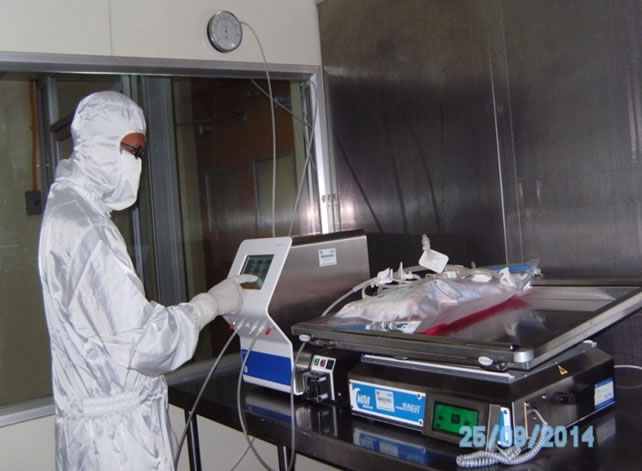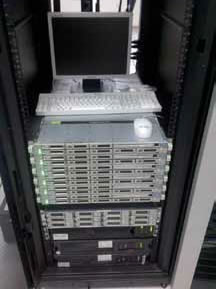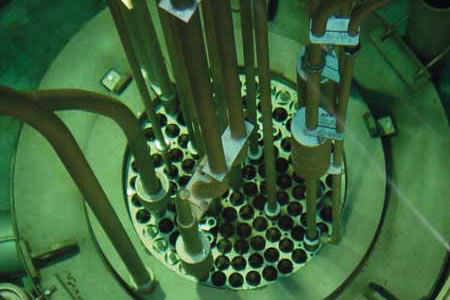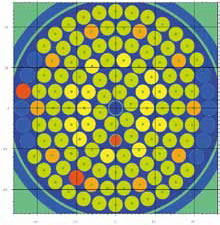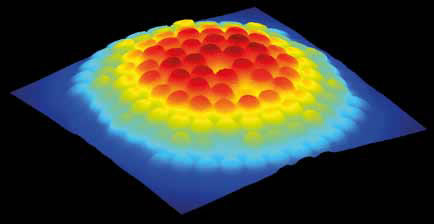Scientific Equipment
The Triple TOF 5600 System is designed to enable new and better ways to conduct mass spectrometry experiments for a broad range of life science applications, such as proteomics, discovering new drugs, detecting biomarkers, and aiding in food safety and environmental analysis.
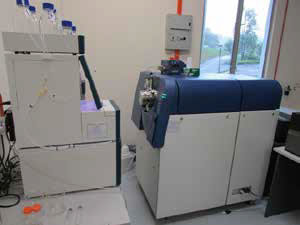
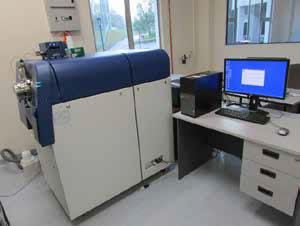
Triple TOF system is able to perform high-resolution mass spectrometer for qualitative and quantitative analysis
A Ball Mill consists of grinding jar and media. It is used in grinding materials like ores, chemicals, ceramic raw materials and paints. Grinding jar rotates around a horizontal axis, partially filled with the material to be ground plus the grinding media. There are various types of grinding media such as ceramic balls, flint pebbles and stainless steel.
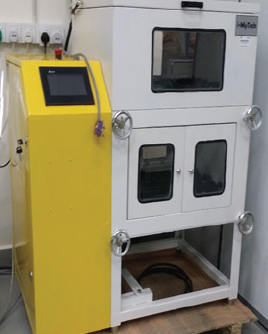 |
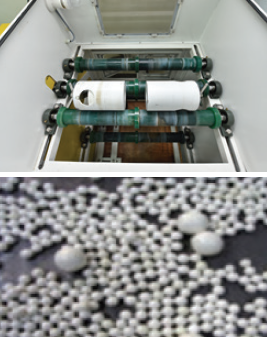 |
| Ball Milling System |
Grinding jar and and Multi size grinding media |
The WAVE bioreactor is widely used in cell culture due to the benefits of disposable technology and ease of use. The system consists of a flexible disposable cellbag and sterile that sits on a rocking thermo-platform. Amongst its application are for the bulk production of monoclonal antibody, viruses as well as insect cells.
|
Single use wave-type bioreactor system for cell culture applications |
WAVE Bioreaktor |
The high content screening system utilizes automated, high-resolution microscopy systems to evaluate multiple biochemical and morphological parameters in cellular systems. The system can perform automated cellular imaging in fluorescent, transmitted light, and phase-contrast modes for fixed- or live-cell assays. In biological research or drug development, high content screening can rapidly identify how small molecules, such as RNAi and drug compounds, affect cell morphology in a quantitative, high throughput manner. Cellular proceses such as apoptosis, cell cycle, micronuclei, angiogenesis, intracellular translocation, endocytosis, cell onoclonal, and multiwavelength cell scoring can also be evaluated using this system.
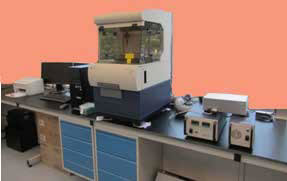
High content screening system provide automated and quantitative cellular imaging and analysis
Cluster computer equipped with the Monte Carlo N-Particle (MCNP) program as a transport protocol that enabled scientists and engineers to simulate neutron economy in nuclear reactor. The cluster is comprised of five computer server for nodes, one master node with six-core each node. The system is widely used for other purposes such as in the construction of nuclear shielding and radiation dosimetry
|
|
|
| Parallel Computer cluster | Top view of reactor core of TRIGA MARK II PUSPATI. |
|
|
|
| Input data of nuclear fuel in reactor core for MCNP used in the simulation of nuclear radiation production at reactor core |
Simulated fast neutron flux distribution at TRIGA MARK II reactor core from MCNPX. Fast neutron flux 1.8x1013 n/cm2/s within core and reduces to 6x1012 n/cm2/s for the most outer ring nuclear fuels |
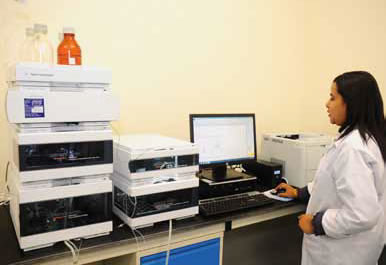
Bioactive compound is being conducted by using Ultra High Performance Liquid Chromatography
Ultra High Performance Liquid Chromatography, (UHPLC) involves isolation and identification of bioactive compounds and development of phytopharmaceuticals or 'standardized herbal medicine'. This system functions as a solid-liquid chromatography high pressure for separation, isolation, purification, fingerprints profiling and identification of active chemical components in any samples or mixtures such as pharmaceuticals, nutraceuticals, foods, natural products, biologicals, lipids, triglycerides, amino acids and etc.
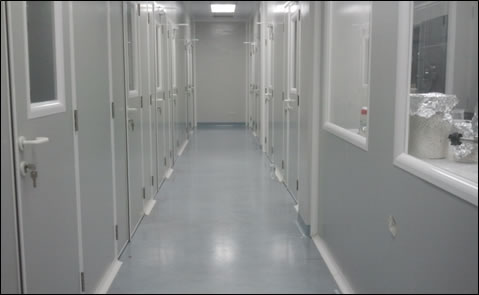
Loji Fitofarmaseutikal
Loji Fitofarmasiutikal telah dibangunkan pada tahun 2012 di Blok 37 dan dalam proses untuk pensijilan Amalan Pengilang Baik (GMP). Loji ini berfungsi sebagai pusat pengeluaran produk-produk fitofarmasiutikal hasil daripada kajian dan penyelidikan di Agensi Nuklear Malaysia. Pegawai bertanggungjawab bagi operasi Loji Fitofarmasiutikal ini adalah Encik Bohari Yaacob dan Encik Daryl Jesus Aropoc.
Terdapat beberapa peralatan yang ditempatkan di Loji Fitofarmaseutikal yang khusus untuk penghasilan produk kapsul dan tablet. Antara peralatan yang ditempatkan termasuklah Granulator Machine, Drying Oven, Capsule Filling Machine, Tableting machine, Tablet Bottling and Labelling Machine dan Tablet Coating Machine. Dengan kelengkapan yang sedia ada, loji ini berkemampuan untuk mengeluarkan 3000-5000 biji kapsul dan 100 ribu tablet setiap jam. Setiap produk yang dikeluarkan akan melalui proses kawalan kualiti untuk memastikan produk yang terhasil menepati tahap piawaian yang telah ditetapkan.
Ujian-ujian untuk kawalan kualitili termasuklah Ujian kekerasan tablet, Ujian kerapuhan tablet, Ujian pengecaian, Ujian logam berat, Ujian mikrobiologi, Ujian kestabilan tablet dan kapsul, Ujian keseragaman berat dan lain-lain. Loji Fitofarmaseutikal ini adalah dalam proses untuk mendapat pensijilan Amalan Pengilangan Baik (GMP). Pensijilan GMP ini adalah penting memastikan setiap produk yang yang dikeluarkan adalah selamat dan berkualiti. Loji ini akan dikendalikan oleh operator-operator yang kompeten dan berkemahiran dalam proses penghasilan produk dan juga berkemahiran dalam menggunakan setiap peralatan. Justeru itu, latihan secara konsisten perlu diberikan kepada setiap operator untuk memastikan tahap kompetensi adalah sentiasa optimum.
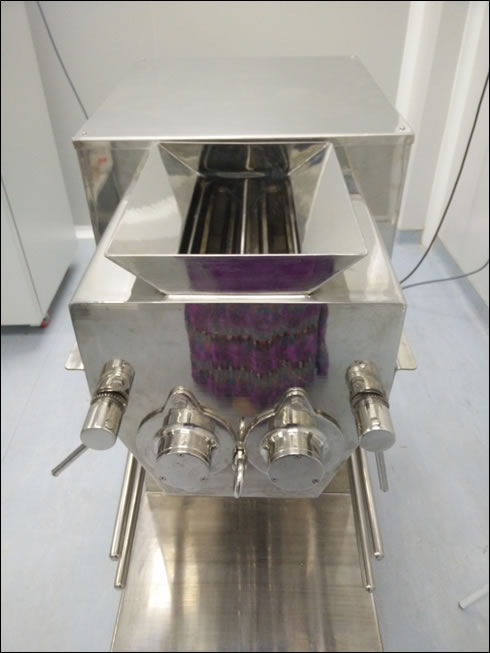 |
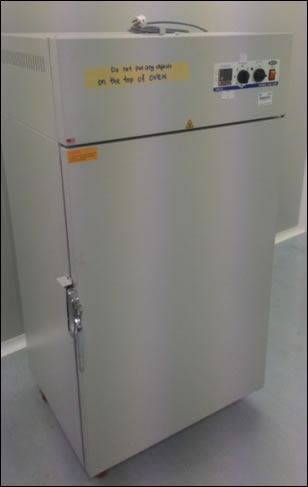 |
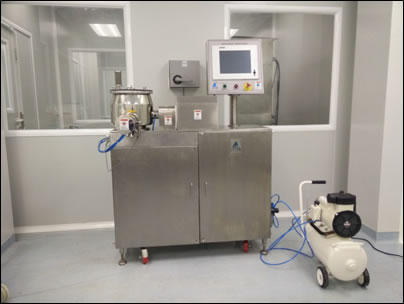 |
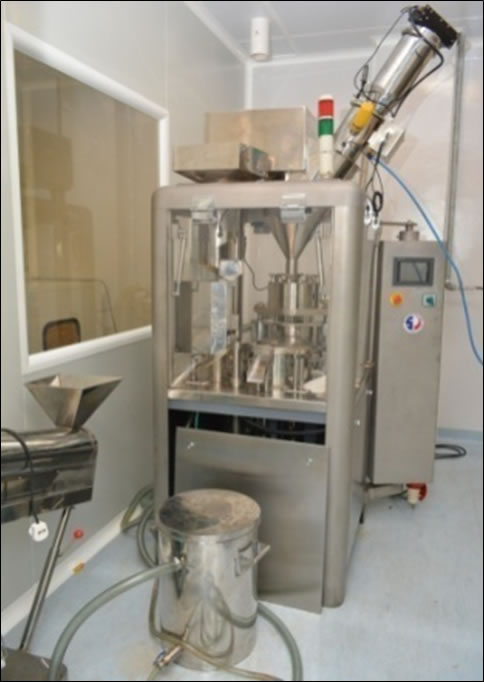 |
|
Drying Oven
|
Granulator Machine
|
Automated Capsule Machine
|
|
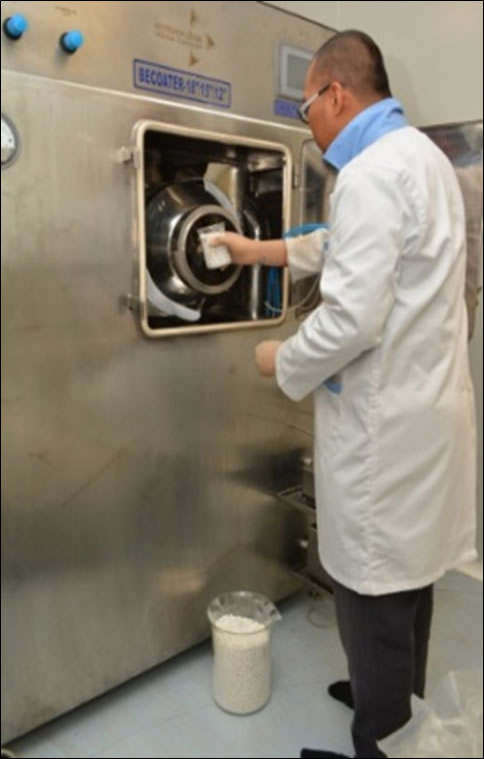 |
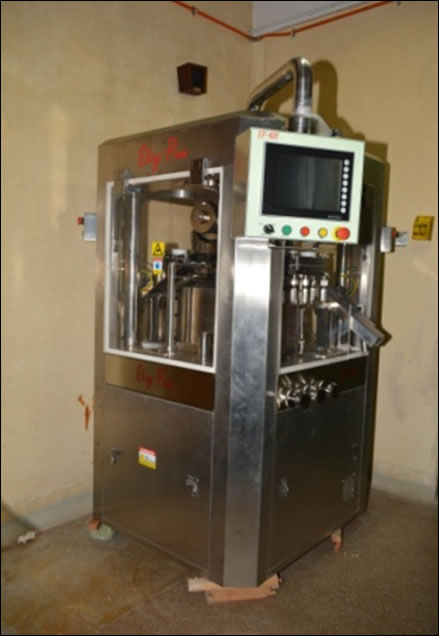 |
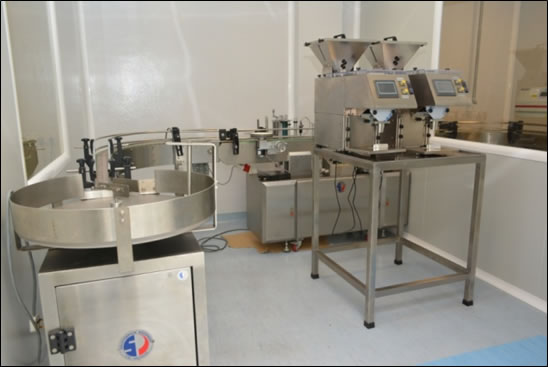 |
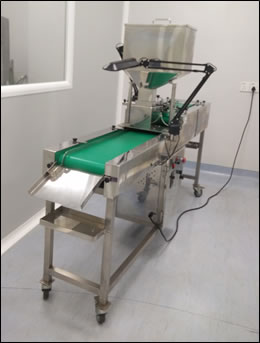 |
|
Tablet Coating Machine
|
Tableting Machine
|
Tablet Bottling and Labeling Machine
|
Tablet Inspection Machine
|
The plant is established to process herbs into formulated medicinal products and is engaged in process development and scale-up of laboratory processes on pilot plant.
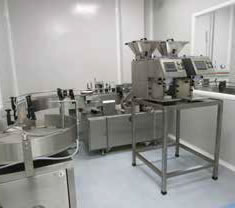 |
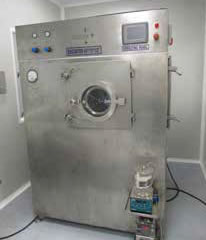 |
|
Mesin pembilang dan pelabelan tablet separa automatik
|
Mesin penyalut tablet
|
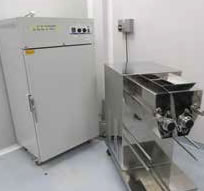 |
 |
|
Mesin pengasingan kumin
|
Pengadun kumin berkelajuan tinggi
|
The vibrating sample magnetometer (VSM) is utilised to characterize the magnetic properties of the materials. Properties of materials such as the magnetic saturation (Ms), magnetic retentivity (Mr) and coercivity forces (Hc) of a material in the magnetic field (Hs) at room
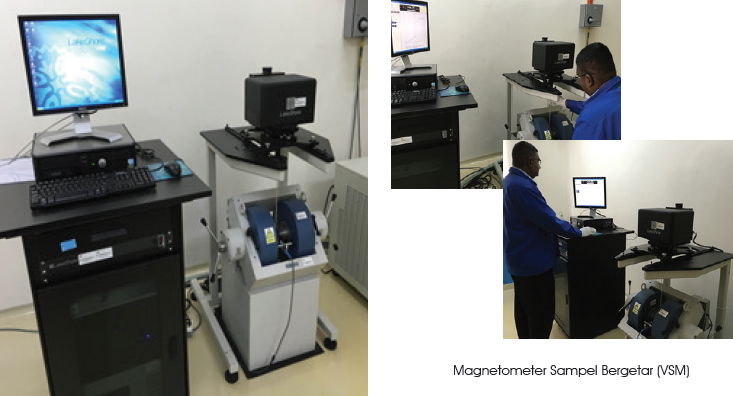
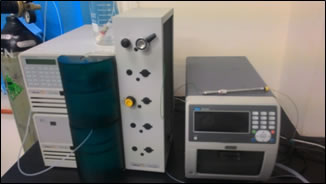 |
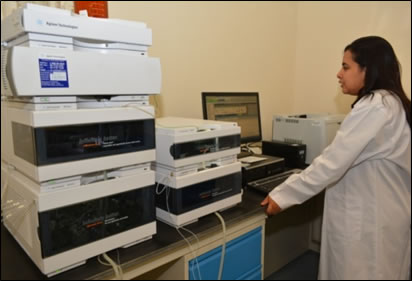 |
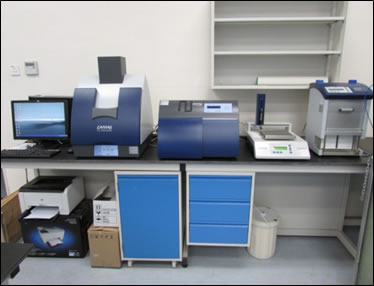 |
|
HPLC-ELSC
|
Ultra High Performance Liquid Chromatography (UHPLC) System
|
Thin Layer Chromatography Scanning and Documentation System
|
Penyelidikan dan pembangunan produk herba melibatkan pengasingan dan pengenalanpastian sebatian bioaktif dan pembangunan fitofarmasuitikal atau standardized herbal medicine. Pencirian sebatian fitokimia adalah penting kerana ia sering dikaitkan dengan kesan terapeutik. Makmal analisis kimia yang terletak di Aras 1, Blok 37 telah dibangunkan pada tahun 2011. Makmal ini dilengkapi dengan peralatan saintifik yang canggih seperti kromatografi cecair berprestasi tinggi iaitu HPLC-ELSC dan UHPLC-DAD serta sistem kromatografi lapisan nipis berprestasi tinggi (HPTLC) bagi tujuan penentuan tabuaran komponen kimia aktif yang hadir dalam ekstrak herba, profill cap jari, analisis kualitatif dan kuantitatif komponen kimia aktif yang dipisahkan
Sistem Preparative HPLC yang dihubungkan kepada sistem Fast Centrifugal Partition Chromatography (FCPC) pula dapat meningkatkan keupayaan pemisahan dan penulenan sebatian kompleks dalam kuantiti yang besar (sehingga 6 g sampel) pada ‘flow rate’ sehingga 250 ml/min. Sistem ini dilengkapi dengan fraction collector memudahkan proses pengumpulan sebatian yang dipisahkan dan proses penulenan terhadap sebatian tersebut dapat dijalankan secara berterusan.
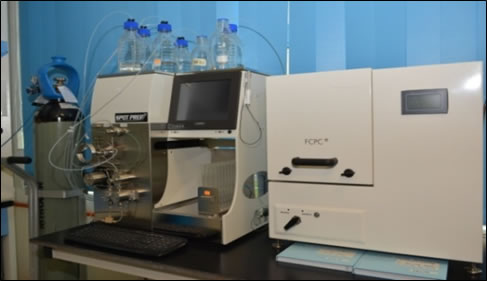
Preparative Liquid Chromatography-Fast Centrifugal Partition Chromatography System
Makmal ini turut dilengkapi dengan sistem LC-Triple TOF-MS/MS yang digunakan bagi memperolehi berat molekul yang berketepatan tinggi untuk pembangunan produk semulajadi. Sistem ini berpotensi menjalankan eksplorasi keseluruhan secara kualitatif yang komprehensif dan penskrinan sebatian aktif dengan mudah. Kepekaan yang tinggi pada alat ini membolehkan pengesanan metabolit dengan pantas (rapid profiling) serta analisis kuantitatif MS/MS yang beresolusi tinggi dilakukan ke atas analit limpahan rendah dalam matriks yang kompleks.
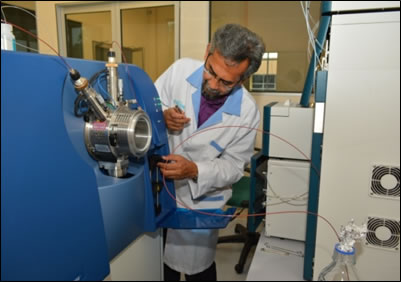 |
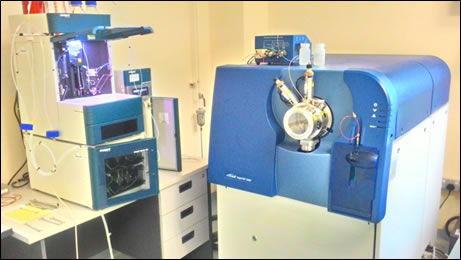 |
|
LC-Triple TOF-MS/MS
|
LC-Triple TOF-MS/MS
|
Makmal Biomolekul telah ditubuhkan pada tahun 2011 selari dengan Penubuhan Pusat Pembangunan dan Kualiti (Blok 37). Makmal ini telah dilengkapi dengan peralatan saintifik yang diperlukan untuk melaksanakan kajian pada peringkat molekular seperti High Content Screening System, Cell Reporter System, Real Time PCR System dan juga EnSpire® Multimode Plate Reader. Antara aktiviti-aktiviti penyelidikan yang dijalankan di makmal ini adalah kajian anti-oksidan, kajian sitotoksik, kajian anti-proliferatif, kajian apoptosis, analisis kitaran sel, kajian pengekpressan gen, kajian translokasi protein dan lain-lain. Di dalam bidang penemuan ubatan, kajian di peringkat molekul adalah penting untuk menentukan keberkesanan dan mekanisma tindakan sesuatu ubatan baru yang dibangunkan.
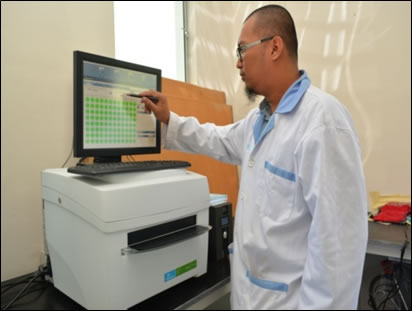 |
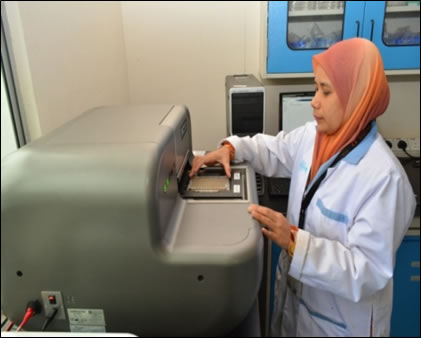 |
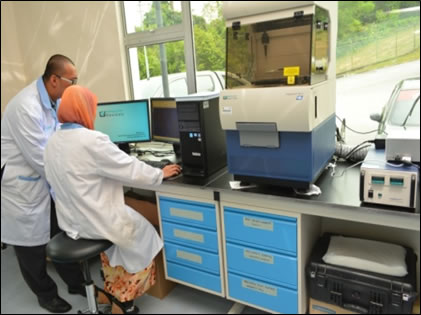 |
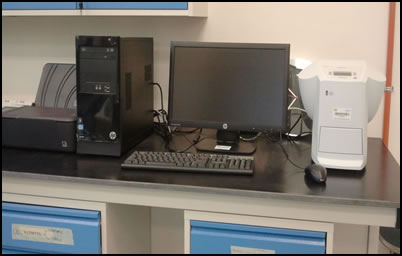 |
|
EnSpire® Multimode Plate Reader
|
Cell Reporter System
|
High Content Screening System
|
Real Time PCR system
|
Makmal Fitokimia terletak di Aras 1 Blok 37. Aktiviti utama di dalam Makmal Fitokimia ini adalah penghasilan ekstrak mentah daripada sampel tumbuhan. Sampel-sampel tumbuhan yang dikutip dari lapangan akan dikumpulkan di makmal ini dan akan melalui beberapa proses seperti pengasingan, pengeringan, pemotongan dan pengisaran. Pengekstrakan sampel kebiasaannya dilakukan secara terus menggunakan air atau pelarut organik atau secara berturutan dalam pelarut organik dengan kepolaran berbeza. Pemeringkatan ekstrak aktif berpandukan kepada bioassay serta pengasingan sebatian aktif anti-kanser juga turut dijalankan di makmal ini. Makmal ini merupakan teras kepada penyelidikan fitofarmaseutikal di Bahagian Teknologi Perubatan. Makmal ini menempatkan peralatan bagi pengekstrakan akues dan pelarut organik seperti Rotary Evaporator, Accelerated Solvent Extractor (ASE) dan Vacuum concentrator.
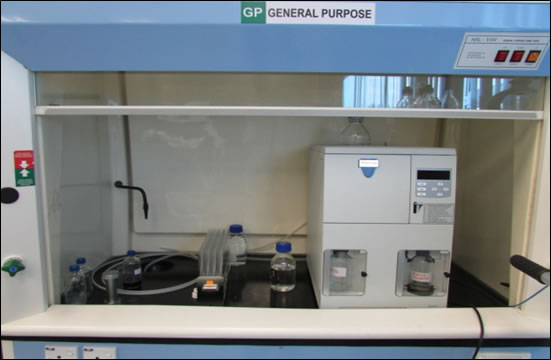 |
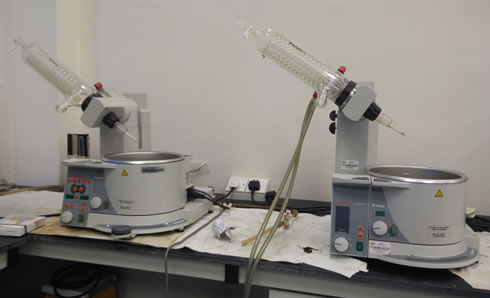 |
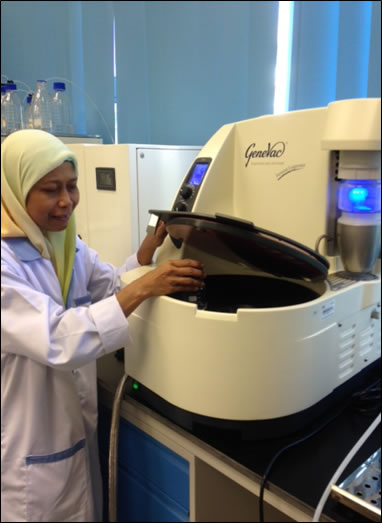 |
|
Accelerated Solvent Extractor (ASE)
|
Rotary Evaporator
|
Vacuum Concentrator
|
Selain itu, peralatan sokongan juga terdapat di dalam makmal ini seperti Pengisar, Drying Oven, Hot plate dan Purified RO Water System. Pegawai bertanggungjawab untuk Makmal Fitokimia adalah Puan Rosniza Razali.
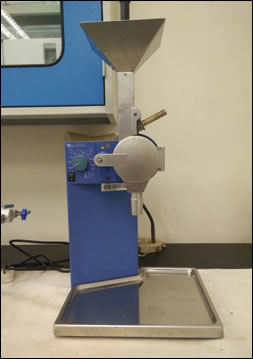 |
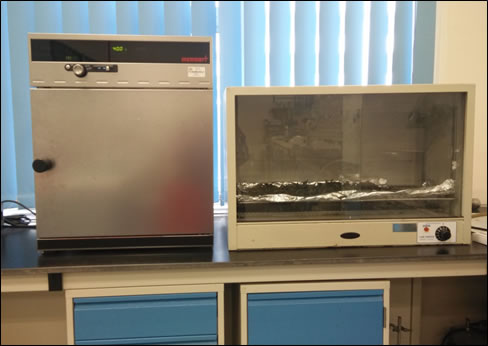 |
|
Pengisar
|
Drying Oven
|
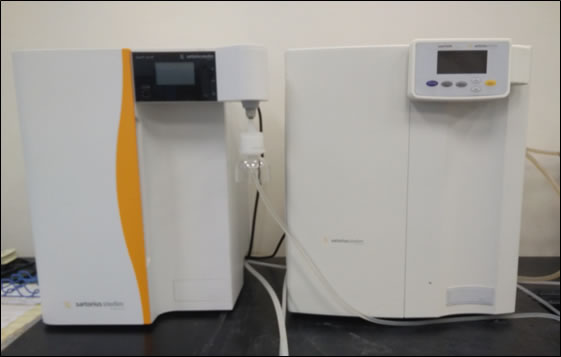 |
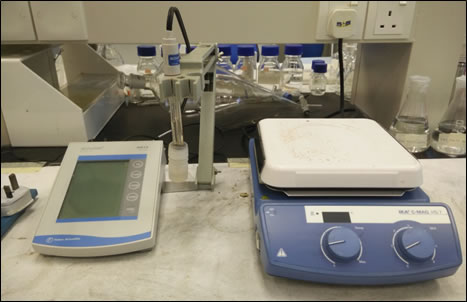 |
|
Purified RO Water System
|
Hot plate and pH meter
|
Makmal kultur sel terletak di Aras 1 Blok 37 telah dibangunkan pada tahun 2012. Makmal ini telah dilengkapi dengan pelbagai peralatan yang diperlukan untuk sebuah makmal kultur sel seperti CO2 Incubator, Inverted Microscope, Biosafety cabinet, Cell Counter dan beberapa peralatan lain seperti Minus 80ºC freezer, peti sejuk, Hot Plate Stirrer dan Water bath. Aktiviti utama yang dijalankan di dalam makmal ini adalah pengkulturan sel-sel normal dan sel-sel kanser yang akan digunakan dalam kajian anti-kanser dan kajian-kajian lain yang berkaitan. Pegawai bertanggungjawab untuk makmal ini adalah En Mohamed Zaffar Ali bin Mohamed Amiroudine.
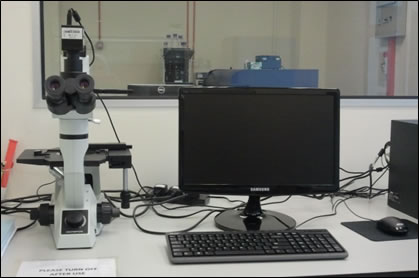 |
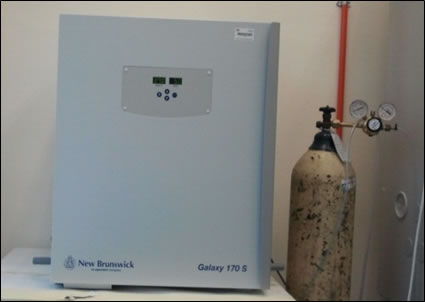 |
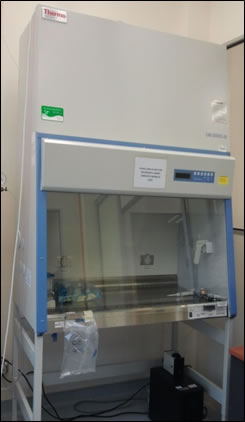 |
|
Inverted Microscope with CCD Camera
|
Carbon dioxide Incubator
|
Class 1 Biosafety Cabinet
|
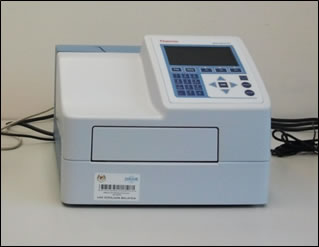 |
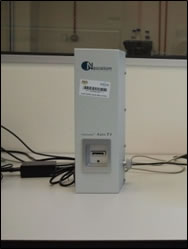 |
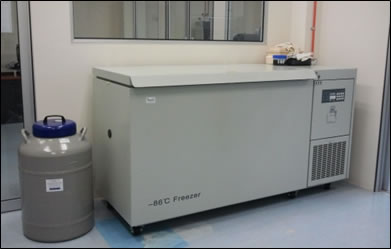 |
|
Elisa Plate Reader
|
Cell Counter
|
Minus 80ºC freezer
|
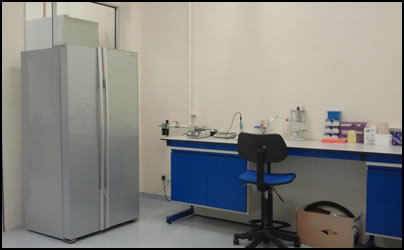 |
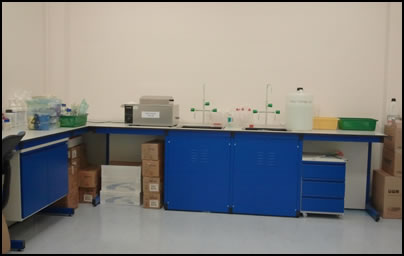 |
|
|
Peti sejuk dan Hot Plate Stirrer
|
Water Bath
|
|
Makmal Histologi (371006) telah ditubuhkan pada tahun 2011 selari dengan Penubuhan Pusat Pembangunan dan Kualiti (Blok 37). Makmal ini telah dilengkapi dengan peralatan saintifik yang diperlukan untuk kajian kesan Toksisiti bahan Fitofarmasiutikal ke atas tisu-tisu organ haiwan ujikaji sehingga di peringkat selular dan boleh dinilai secara mikroscopik sehingga 1000x pembesaran. Peralatan–alatan yang membina sistem ini adalah terdiri daripada, Automatic Tisue Processor, Embedding centre, Semi-automatic Microtome, Automatic-stainner dan sistem Microscopic.
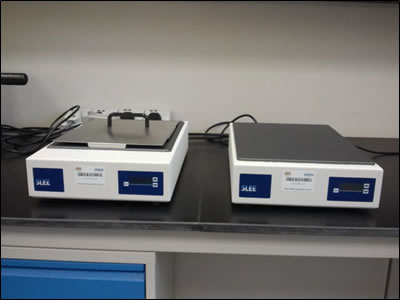 |
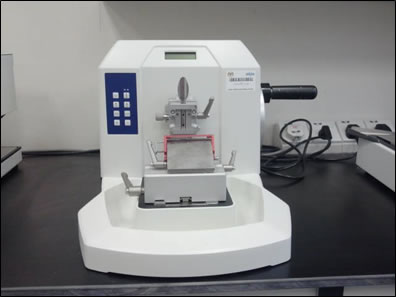 |
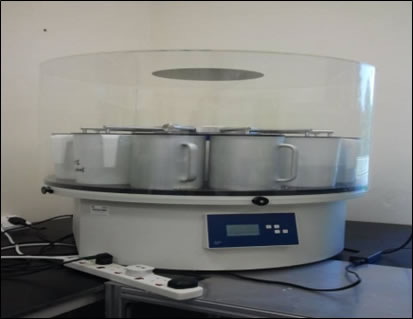 |
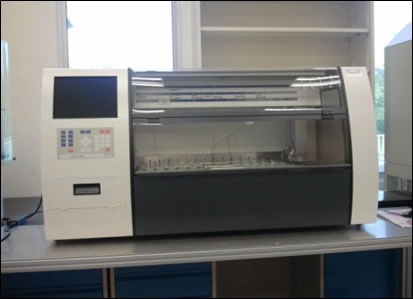 |
|
Tissue Embedding Centre
|
Semi-Automatic Microtome
|
Automatic tissue Processor
|
Automatic Slaid Stainer
|
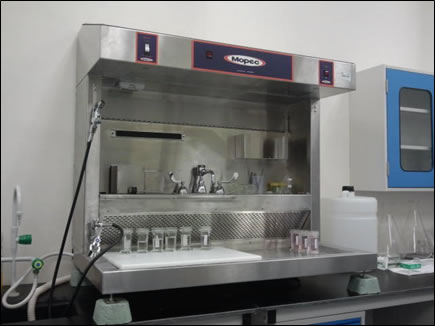 |
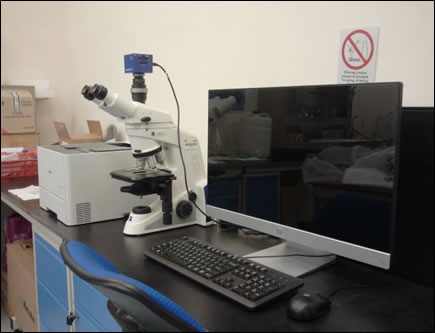 |
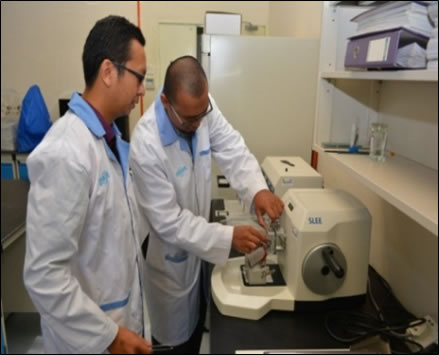 |
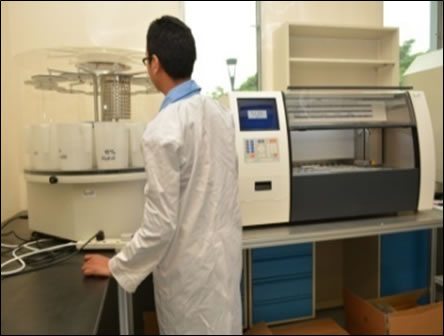 |
|
Histology Workstation
|
Light Microscope System
|
|
|
Makmal Toksikologi telah ditubuhkan pada tahun 2011 selari dengan Penubuhan Pusat Pembangunan dan Kualiti (Blok 37). Makmal ini menempatkan beberapa peralatan saintifik seperti Biochemical Analyser, Electrolyte Analyser, Stereo Microscope, Refrigerated Centrifuge dan set peralatan untuk ujian ketoksikan anak udang.
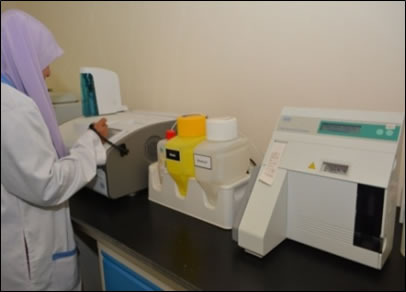 |
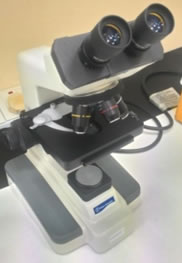 |
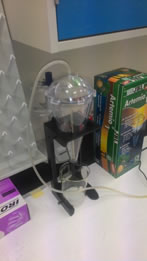 |
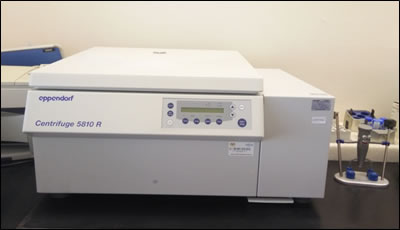 |
|
Biochemical dan Electrolyte Analyser
|
Stereo Microscope
|
Brine Shrimp Hatching System
|
Refrigerated Centrifuge
|
Sebuah lagi peralatan berteknologi tinggi untuk kajian toksikologi iaitu Hematology Analyser telah ditempatkan di Makmal Biologi blok 24 yang berdekatan dengan Rumah Haiwan Ujikaji bagi memudahkan analisa sampel darah tikus dijalankan. Alat Hematologi merupakan satu-satunya alat yang dilengkapi dengan software multi-spesiss khusus untuk penganalisaan sampel darah haiwan selain dari sampel darah manusia. Selain daripada itu, di Makmal Toksikologi juga terdapat Sistem Akuarium Ikan Zebra yang akan digunakan dalam kajian ketoksikan embrio ikan zebra. Kajian toksikologi adalah amat penting di dalam pembangunan ubatan baru kerana kajian ini akan menentukan tahap keselamatan sesuatu ubatan yang dibangunkan. Tahap ketoksikan sesuatu ubatan akan disaring secara in vivo menggunakan anak udang dan embrio ikan zebra. Seterusnnya kajian toksikologi akan dilakukan secara akut, sub-kronik dan kronik menggunakan model haiwan. Pegawai bertanggungjawab untuk makmal Toksikologi adalah Puan Fazliana Mohd Saaya.
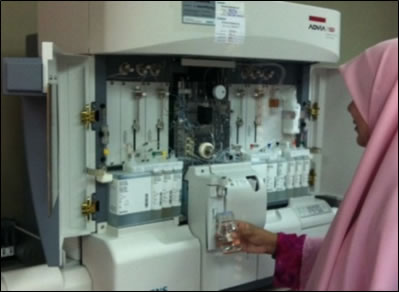 |
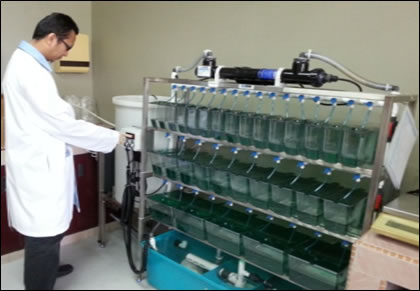 |
|
Hematology Analyzer
|
Zebra Fish Aquarium System
|
Survey meters are portable radiation detection and measurement equipment used to check personnel, equipment and facilities for radioactive contamination or to measure ambient ionising radiation (to evaluate direct exposure hazard). The hand-held survey meter is the most well known radiation measurement equipment to the public because of its extensive use. The most commonly used hand-held survey meters are the scintillation counter for the measurement of alpha, beta and neutron particles; Geiger counter which is widely used to measure alpha, beta and gamma levels; and ion chamber which is used for the measurement of beta, gamma and x-ray. Nuclear Malaysia uses various types of survey meters to measure the lowest up to high doses.
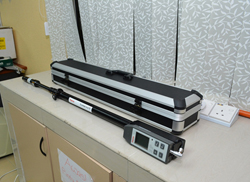 |
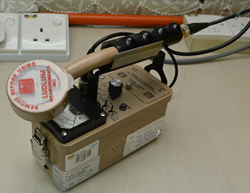 |
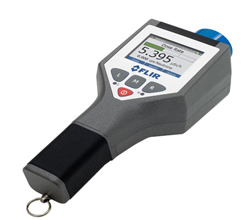 |
|
High dose survey meter
|
Low dose survey meter
|
Nuclide identification survey meter
|
Atomic force microscope (AFM) (Photo 1) is one of the main tools for imaging and measuring at the nanoscale. AFM is rather different from other microscopes as it. It does not form an image by focusing light (optical microscope) or electrons (electron microscope) onto a surface. It physically ‘feels’ the sample’s surface with a sharp probe, building up a map of the height of the sample’s surface. This is very different from an imaging microscope which measures a two-dimensional projection of a sample’s surface. Such a two-dimensional image does not have any height information in it. Therefore, the sample must be rotated in order to see height of the feature. The data from an AFM must be treated to form an image (Photo 2) and the treatment is rather simple and very flexible. From the collected height data, images can be generated using simple analysis software. The height data simplifies the measurement of height, length, width or volume of any feature in the image.
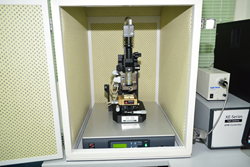 |
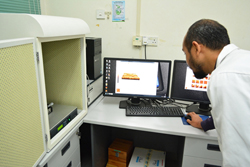 |
|
Atomic force microscopy (AFM)
|
Sample image data generated by the atomic force microscopy (AFM) were analysed using the software
|
This desktop scanning electron microcopy (SEM) can be used in the fields of material science, semiconductor, gemology, medical, forensic science, life science and education. It consists of an imaging unit and is equipped with a 19'' monitor, rotary knob, power supply, pre-vacuum pump and standard sample holder. The magnification range for a desktop SEM is about 20 – 15,000-x. High resolution SEM images can be obtained by using acceleration voltages of about 5 kV, 10kV and 15kV for outstanding high resolution SEM images. One of the major advantages of this SEM is it requires less than 30 seconds for sample loading and unloading. Sample preparation involves simple and fast process which allows direct imaging without any prior coating. The energy consumption is very low for this type of SEM.
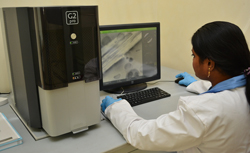 |
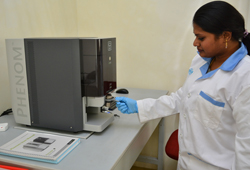 |
|
Dekstop scanning electron microcopy (SEM)
|
Sample preparation for imaging using desktop SEM
|
Microstereolithography technology is utilised in the manufacturing and biomedical field for fabricating imprinted structures. The fabrication process is an additive layer process, in which the process is repeated layer by layer to construct a full three dimension (3D) structure. These structures are formed through cross linking bonds formed from photo polymerization process such as ultraviolet (UV), laser or near-infrared laser. The technique offers low cost of production, is efficient and precise, and also the processing system is able to increase product durability.
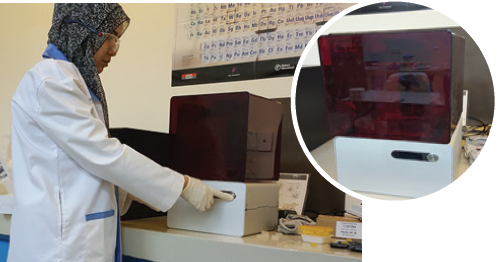
Microstereolithography is utilized for imprinted structures fabricating and capable of
recognizing a targeted analyte
The AFFFF-MALLS is a combined method for analysis and characterization of a variety of polymers and related materials. AFFFF provide separation method for molar mass fraction and the MALLS is employed for molecular structure analysis. The AFFFF is used to separate larger molecules, aggregates and particles, based on polymer size. In the AFFFF system, the separation process is obtained by the difference in mobility (where small molecules diffuse faster than big molecules) in the flow field induced by liquid flow (eluent) over the membrane and across the channel.This AFFFF-MALLS system consists of different detectors such as multi angle laser light scattering, differential refractive index and UV absorbance cell, which allows the determination of average molecular weight (MW), average molecular weight number(Mn), root mean squared radius (of gyration) (Rg) and second viral coefficient (A2) of the polymers. Futhermore, the AFFFF-MALLS analysis also provides information on the shape (conformation) of the polymers, diffusion coefficients and hydrodynamic radius. Examples of samples which can be analyzed using the AFFFF-MALLS are
- synthetic or natural polymers,
- nano/micro colloidal particles,
- environmental samples and
- biological materials.
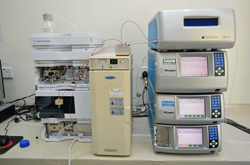
AFFFF-MALLS System
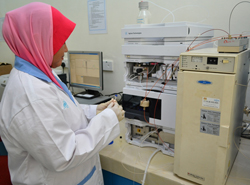
Samples analysing using AFFFF-MALLS
Liquid Scintillation Counter, Quantulus is a dedicated counter for environmental samples with proven, unsurpassed performance measuring extremely low concentrations of man-made, cosmogenic and other natural radionuclides. This equipment is used for alpha/ beta counting, especially for samples containing a mixture of alpha/beta/gamma radiation. It has a high counting performance with low 3H. The technique of mixing active material with a liquid scintillator for more efficient counting have been used to measure the activity of radioactive sample, and the resultant photon emissions counted. Some chemical compounds and colored samples can interfere with the counting process. This interference, known as "quenching", can be overcome through data correction or careful sample preparation. High-energy beta emitters such as phosphorus-32(32P)can also be counted in a scintillation counter without the cocktail, but using an aqueous solution instead. This technique known as Cerenkov counting relies on the Cerenkov radiation being detected directly by the photomultiplier tubes. The Cerenkov technique is normally used forquick and rough measurements, since the geometry of the sample can create variations in the output. This equipment is suitable for applications such as radiocarbon dating and Cerenkov counting which meets the requirements of private and government agencies particularly for measurement of tritium (3H) in urine samples, water and ice.
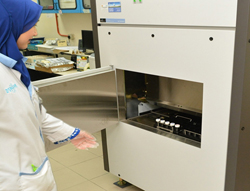
Ultra low liquid scintillation counter
Thyroid counter is used to evaluate intake of radionuclide in the human body (Fig. 1.a). This counter can be used for in-vivo monitoring to assess accumulation of Iodine-131 and Iodine-125 in the thyroid gland, as well as for in-vitro monitoring to verify radioactivity in blood samples. This thyroid counter system equipped with a 2 in. x 2 in. NaI:Tl scintillation detector is suitable to detect gamma emitter with energies greater than 100 keV. In the Medical Physics Group, the counter is used for research related to internal dosimetry, establishment of thyroid counter calibration services in Malaysia and training for local and foreign students. Internal dose due to exposure to unsealed sources among radiation workers can be monitored using the counter. The counter can also act as a radiological emergency preparedness equipment to monitor intake of radionuclides by the public. Caesium-137 (33 and 662) keV and Europium-152 (32.9, 40.8, 121.8, 344.8 and 661.7) keV radioactive sources having radioactivity of 0.5 nCi; and neck phantom used in calibration of thyroid counter are shown in Fig. 1.c.
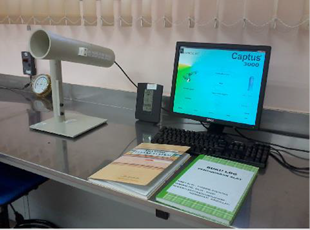
Fig.1: (a) Captus 3000 Thyroid Uptake System.
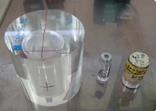
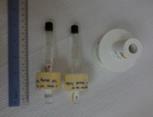
Fig 1: (b) Neck phantom and a vial of Iodine-131. (c) Cs-137 and Eu-15 rod type sources, and source holder.
Whole body counter is a device used to measure and identify radionuclides in the body or organ. The measurement is primarily applicable to radioactive material that emits gamma rays and is determined by employing an external radiation detector. The advantage of whole body counting is the ability to measure the content of radionuclides in the body directly, does not rely on indirect methods (such as urinalysis) and able to measure insoluble radionuclides in the lungs. This method is called a direct measurement or in vivo monitoring.
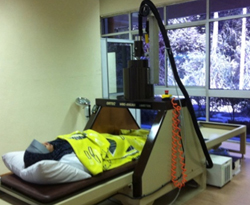
Whole body counter
The multimode plate reader reads optical biosensor label-free, fluorescence intensity, absorbance, ultra-sensitive luminescence and patented Alpha technologies in microplates up to 384-wells.
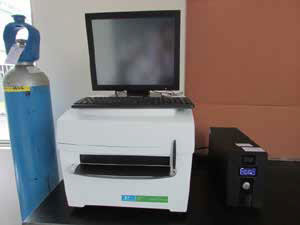
Multi-mode plate reader offering multiple detection modes – UV-vis absorbance, fluorescence and luminescence for various applications
Landaver Mocrostar give reading for optically stimulated luminiscene (OSL) disimeter. It can analyses two types of OSL which are INLIGHT/ALBEDO Badge and NANODOT Chip. OSL dosimeter reading process can be done repeatedly using Microstar reader without reading impairment occurs at OSL dosimeter.
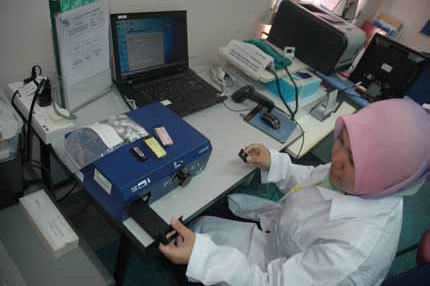
Operator is conducting NANODOT chip analysis using OSL reader
Dose calibrator is used to measure radioactivity of radiopharmaceutical before being administered into human body for diagnosis or treatment (therapy) of disease in nuclear medicine. The calibrator can provide prompt reading of radioactivity in Becquerel (Bq) or Curie (Ci). In nuclear medicine, accuracy of the activity of Technetium-99m, Iodin-131 and Fluorin-18 is very important to ensure patients are given the exact dose. There are two units of dose calibrator in the Medical Physics Group which are Fidelis Secondary Standard Radionuclide Calibrator and Dose Calibrator Model CRC-15R.
The Fidelis Secondary Standard Radionuclide Calibrator is the national reference standard dose calibrator for calibrating other dose calibrators in nuclear medicine centres and radioisotope production facilities in Malaysia. It has traceability to the National Physical Laboratory (NPL) in the United Kingdom. Dose calibrator Model CRC-15R is use in research related to nuclear medicine and training for local and foreign students. Four standard sources used in the calibration of dose calibrator, research and training i.e. Cobalt-57, Barium-133, Caesium-137 and Cobalt-60 as well as a calicheck kit which is used to determine decay of Technetium-99m in linearity test of dose calibrator are also available in the laboratory (Fig. 1).
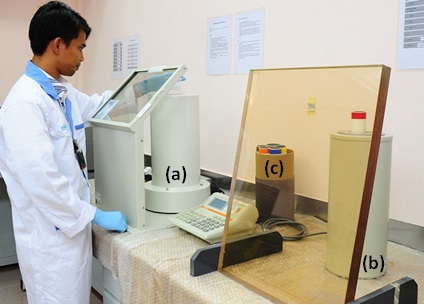
(a) Fidelis Secondary Standard Radionuclide Calibrator, (b) dose Calibrator Model CRC-15R and (c) Calicheck kit.
The portable gamma nuclide identifier is used for gamma ray detection and radionuclide identification. It can be used for laboratory or on-site field measurement. The device consists of two detectors for determining the gamma dose rate over a wide range from <0.05 μSv/h to >10000 μSv/h and can make an accurate and fast determination without the need for expert intervention.
For low dose rates (below 20 μSv/h), the dose rate is determined from the high purity germanium (HPGe) detector spectrum. For dose rates above this value, the internal compensated Geiger Muller tube is automatically used. The relative efficiency and resolution of the detector at Co-60 energy 1333 keV is 45% and 1.96 keV, respectively. The detector is cooled by a miniature, high reliable mechanical cooler, and does not require liquid nitrogen. This device includes a global positioning system (GPS) and can be connected to an external computer for Multi Channel Analyser (MCA) operation.
The Simultaneous Thermal Analyzer (STA) refers to the simultaneous use of thermogravimetric (TGA) and Differential Scanning Calorimetry (DSC) applications for the same samples. Therefore, it produces more information rapidly. STA measures mass changes and thermal effects between -150°C and 2400°C. Information such as phase transformation, decomposition, condensation, pyrolysis, oxidation and combustion of a sample can be obtained using this analyser. It is equipped with a micro scales, electric furnace, founder systems, cooling systems, hardware and software for thermal analysis.
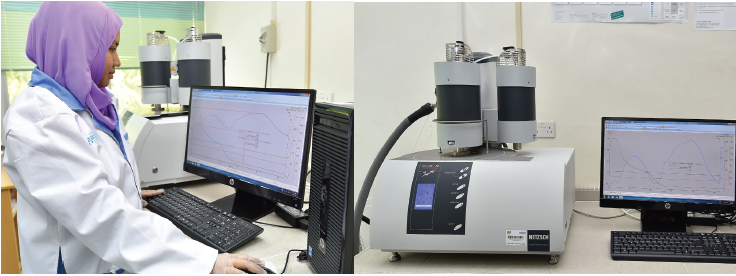
Simultaneous Thermal Analyzer (STA)
Petelelihat akustik berfungsi untuk menghasilkan imej yang berkualiti tinggi dalam mengenalpasti dan mengorientasi keretakan, kajian stratigrafi, kajian tekanan tempatan dan orientasi teras. Di Nuklear Malaysia, peralatan ini digunakan untuk menjana imej dinding lubang gerudi dengan menghantar denyutan ultrabunyi terhadap pembentukan sensor berputar, merekodkan amplitud dan masa perjalanan isyarat yang dipantulkan. Rekod amplitud memaparkan kontras “impedance” (galangan) antara batuan dan cecair. Masa perjalanan digunakan untuk menentukan ketepatan data diameter lubang gerudi, menjadikan alat yang unggul untuk mendiskripsi kecacatan lubang gerudi.
Sebelum sebarang analisis dilakukan, data perlu diproses terlebih dahulu. Beberapa proses yang terlibat di dalam penambahbaikan kualiti data ialah:
(i) interpolasi (sisipan) data yang hilang
(ii) penormalan imej
(iii) imej terintergrasi
(iv) penalaan kontra dan kecerahan
Data boleh dipaparkan sebagai imej, lengkungan atau paparan silinder 3D. Setiap fitur planar merakam azimut, kemiringan dan bukaan. Setiap ciri fitur boleh dikategorikan dengan menggunakan perisian ToadCAD. Perisian ini akan memberikan pemahaman terhadap struktur, termasuk ruang kerja dengan polar kemiringan, menaik dan plot vektor. Modul perisian merangkumi proses-proses tertentu seperti pengiraan “calipers” daripada imej masa perjalanan, menunjukkan kekuatan batu dan pemantulan imej.
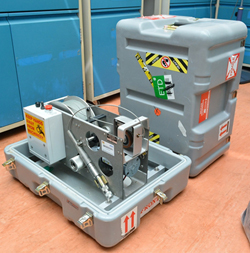
Petelelihat akustik digunakan untuk menghasilkan imej yang berkualiti tinggi dalam mengenal pasti keretakan dinding lubang gerudi
There are three units of medical X-ray apparatus installed at the Medical Physics Group which are Bennett Mammographic Model MF-150G, Toshiba General Radiography Model KXO-50S and Toshiba Mobile C-arm Model SXT 1000A & TV system (Fig.1). These irradiating apparatus are used for calibration of test tools used in quality control of medical X-ray machine such as dosemeter, kVp meter and exposure timer. Other than that, the machines are used in research activities and training of staff, trainees and students.
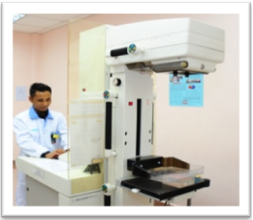
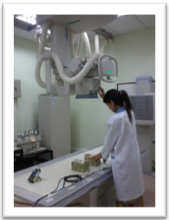
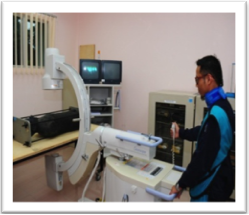
Figure 1: (a) Bennett Mammographic Model MF-150G. (b) Toshiba General Radiography Model KXO-50S. (c) Toshiba Mobile C-arm Model SXT 1000A & TV system.
Fig. 2 shows PTW Unidos electrometer Model T10002 and standard ionization chambers which are used as the national reference standard dosemeter. These standard equipment are traceable to the International Atomic Energy Agency (IAEA).
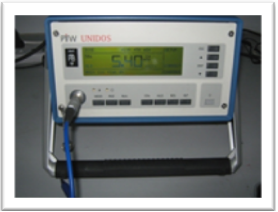
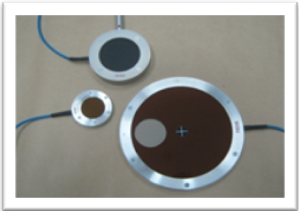
Figure 2: (a) PTW Unidos Electrometer Model T10002. (b) Three ionization chambers of various sensitive volumes used in the calibration of diagnostic dosemeters.
The laboratory is also equipped with multiple types of phantoms and radiation detectors that can be used in research activities. Phantoms such as RANDO phantom, water phantom, breast phantom and CDRH phantom are available for research related to patient dosimetry (Fig. 3). The laboratory also has relative detectors such as thermoluminescence dosimeter types TLD-100 powders and TLD-100 chips suitable for use in radiotherapy and diagnostic radiology dosimetry, respectively (Fig. 4.b). The irradiated TLD is analysed using Harshaw 3500 TLD Reader System (Fig. 4.a). For those interested in research related to medical imaging, the laboratory provides NAOMI digital imaging system, computed radiography (CR) reader and automatic film processor (Fig. 5). Dark room for film processing and test tools such as sensitometer and densitometer for sensitometric measurement are also provided by the laboratory (Fig. 6). Various types of test tools for use in quality control of medical X-ray machines such as multifunction meter, collimator and beam alignment test tools, focal spot size test tool, film illuminator and survey meter are also available in the laboratory (Fig. 7).
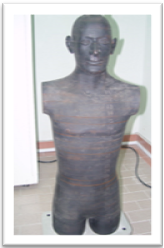
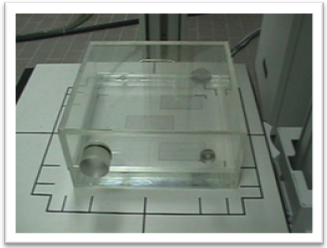
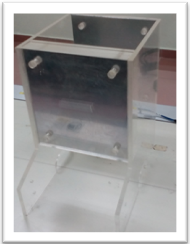
Figure 3: (a) RANDO phantom. (b) Water phantom. (c) CDRH phantom.
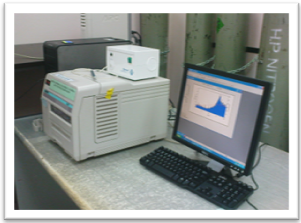
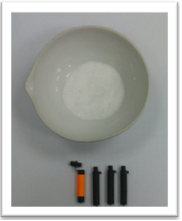
Figure 4: (a) TLD reader Harshaw 3500. (b) TLD-100 powders and capsules for radiotherapy dosimetry.
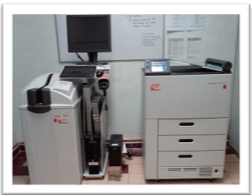
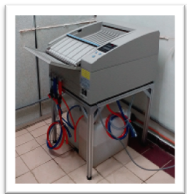
Figure 5: (a) Carestream Directview Classic CR Reader. (b) Dryview Laser Imaging Model 6850 and JPi Automatic Film Processor Model JP-33.
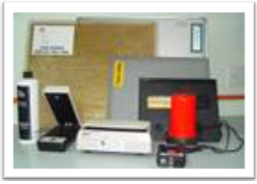
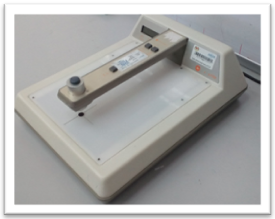
Figure 6: (a) Various sizes of film cassettes, sensitometer and densitometer for sensitometric test. (b) Standard densitometer with standard film strip traceable to NIST.
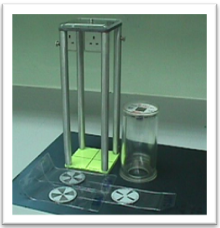
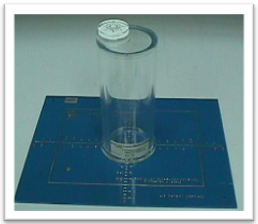
Fig. 7: Test tools used to determine collimator & beam alignment and focal spot size.
Besides providing our technical staff with in-house training, all facilities in the laboratory are also used to support external training such as IAEA’s fellowship programme, IAEA’s Post Graduate Educational Course (PGEC) and Medical X-Rays for Medical Practitioner Course organised by Nuclear Malaysia’s Training Service Unit. The laboratory is also used in research collaboration with local universities and industrial training programme.
The Jacketed Reactor is designed to synthesize material in large scale (eg. titanium dioxide and thorium). The cooling or heating jacket around the vessel through which a cooling or heating fluid is circulated therefore enhanced synthesizing parameters. This resulted in an increased conversion of reactant feed to product, besides that the purity of product also enhanced.
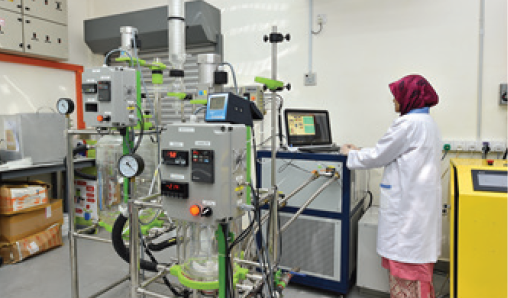
Jacketed Reactor System
Sangkar konvensional di Rumah Haiwan Ujikaji (Blok 24) telah ditukar sepenuhnya kepada “Sangkar Berventilasi Individu” (IVC) bagi memastikan haiwan ujikaji yang dibiakkan serta dipelihara berkualiti tinggi, bebas jangkitan serta sihat. Di Rumah Haiwan Ujikaji ditempatkan satu unit IVC untuk tikus (yang boleh memuatkan 80 sangkar) dan dua unit IVC untuk mencit (40 sangkar mencit bagi setiap unit). Udara yang keluar dan masuk ke dalam sistem IVC ini ditapis dengan penapis HEPA dan aliran udara keluar- masuk sehala yang berasingan untuk mengelakkan kontaminasi udara. Sistem ini juga dilengkapi dengan penyalur udara keluar bagi meminimakan masalah pencemaran bau di dalam Rumah Haiwan Ujikaji. Penggunaan perlapisan dan diet yang sucihama juga menjamin haiwan di sini bebas daripada jangkitan hama, kutu dan kuman. Stesen penukaran perlapisan juga turut dipasang dan digunakan bagi memastikan tiada berlaku pencemaran silang semasa menukar pelapisan. Haiwan yang berkualiti dan bebas dari jangkitan penyakit akan menjamin ketepatan hasil yang diperoleh daripada penyelidikan fito dan radiofarmaseutikal yang dijalankan di BTP.
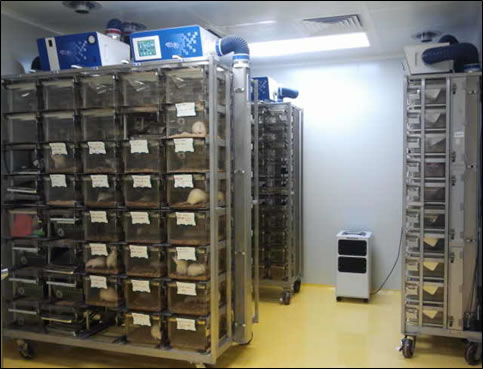
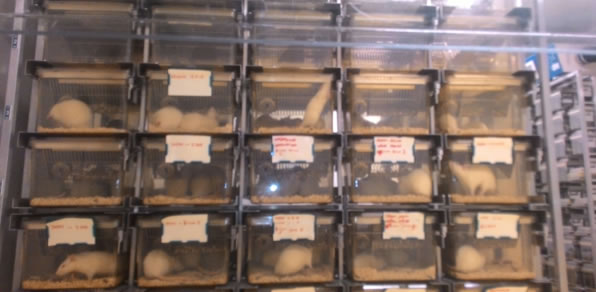
Sangkar
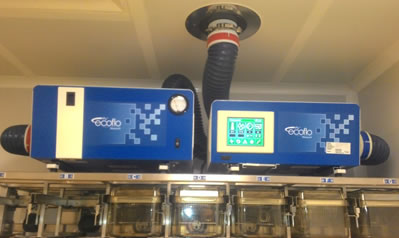
Ducting System
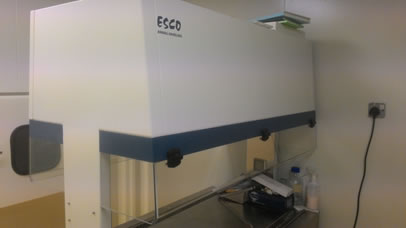
Working Station
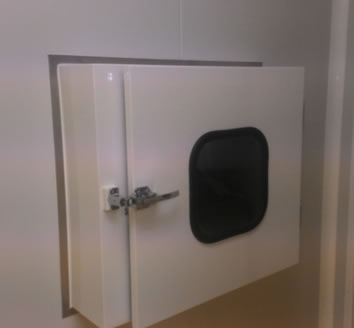
Smart Alert Radiation Detection (SARD) system monitors the area monitoring and alerts the user when radiation level is more than a permissible level. SARD is 24 hours operating system that powered by solar energy and equipped with a Geiger Muller Counter application. For dose level measurement, the pulse from GM will be converting to count per minute (cpm). The cpm reading is used to obtain radiation dose in uSv/h. The system can record and tracking the dose rate every 3 seconds and will send them to a Cloud database though wifi platform to give signals to the worker. A special platform by using android is also being developed. Photo shows SARD installed at radioactive waste storage area for toughness and data stability testing before being applied at thorium pilot plant.
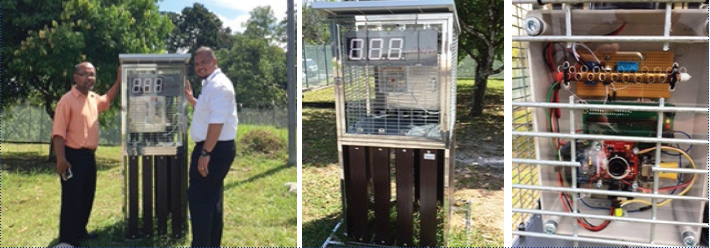
SARD located at field site to test its toughness and data stability before being applied
Biological dosimetry is used to measure the radiation dose of ionizing radiation based on the damage and changes in the chromosome structure. Metaphase finder system is capable for recording, identifying and storing images of chromosomes (metaphase). The stored images are analyzed using metafer software to identify the frequency of chromosome aberrations such as dicentrik and translocation chromosomes. With the availability of this equipment, monitoring of radiation doses to workers and public can be carried out quickly and efficiently.
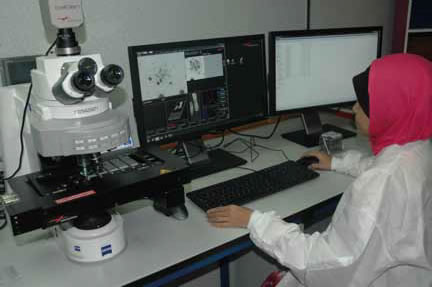
Chromosome analysis is being conducted using metafer software
Sistem Fluorescence Molecular Tomography (FMT) diperolehi pada tahun 2013 melalui peruntukan pembangunan RMK10. Sistem Fluorescence Molecular Tomography yang ditempatkan di makmal Biologi (Blok 37) merupakan kombinasi mikroskop digital 3D dan pengimejan tomographic near-infrared (NIR) bagi membolehkan penentuan kuantitatif taburan fluorochrome secara 3D dalam tisu haiwan secara mendalam. Alat ini boleh digunakan dalam pelbagai aplikasi penyelidikan dan pra-klinikal. Gabungan FMT dengan kaedah pengimejan struktur seperti X-ray computed tomography (CT) dan Magnetic Resonance Imaging (MRI) akan membolehkan pemetaan anatomi molekul pada rujukan definisi tinggi. Sistem FMT ini boleh digunakan untuk pelbagai aplikasi penyelidikan merangkumi bidang "onkologi" (kanser), "inflammatory","pulmonary", "cardiovascular" dan penyakit tulang. Melalui penggunaan sistem FMT, mekanisma biologi sesuatu penyakit dan tindak balas terapeutik dapat difahami dengan lebih jelas. Di Bahagian Teknologi Perubatan Agensi Nuklear Malaysia, sistem ini akan digunakan untuk projek penyelidikan dan pembangunan produk fitofarmaseutikal untuk rawatan kanser yang merupakan projek teras Kumpulan Teknologi Farmaseutikal. Bahagian Teknologi Perubatan juga bercadang untuk menawarkan hidmat analisis sampel/tisu menggunakan sistem FMT kepada penyelidik-penyelidik lain sama ada dalaman ataupun dari agensi penyelidikan luar.
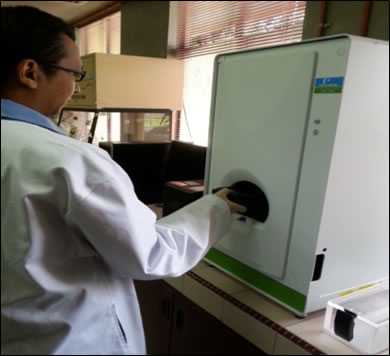
Sistem Fluorescence Molecular Tomography
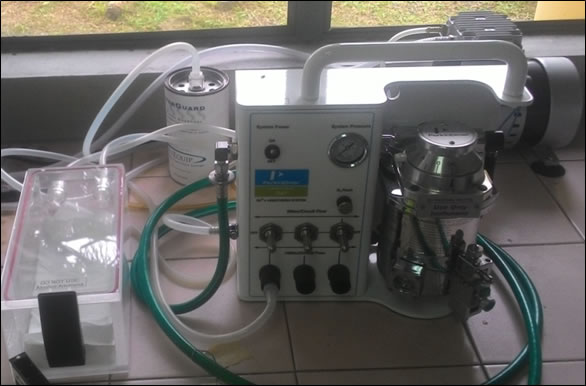
Unit Pembiusan Sistem Fluorescence Molecular Tomography
The system consists of a microtome, tissue embedding system, staining and tissue processing equipment. It is used to prepare slides for studying microscopic anatomy of cells and tissues of plants and animals.
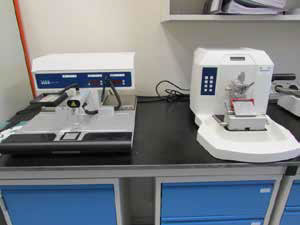
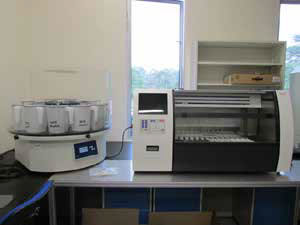
Histology system Microtome (left) and tissue embedding system; (right) – Units for staining and tissue processing
Low Background Alpha/Beta Counting System is equipped with four counting drawers, suitable for applications that require multiple samples measured at the same time and require a long counting time. It is also equipped with P-10 (90% argon, 10% methane). This equipment can reduce the use of P10 by 50% compared with the old model. The main application of this equipment is for measurement of gross alpha/gross beta radioactivity in various environmental samples, including water, soil, sediment, smear test sample, ice, dust, air, and also to analyse the efficiency of water filtration systems.
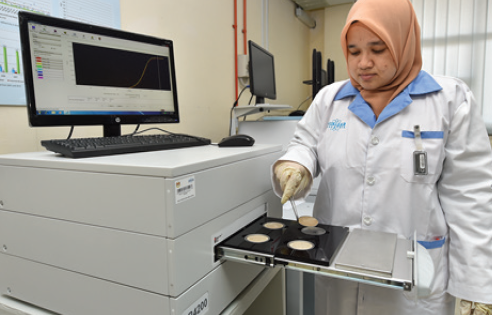
Analyst is placing a sample into the Low Background Alpha/Beta Counting Multy-
Detector System
Chemical Vapor Deposition (CVD) Syste is a widely used for materials-processing technology. The main application is in a surface coating; in silicon wafer fabrication industries and thin film modification. Due to its wide application, the use of CVD system can be expanded to deposit the monomer, glycidyl methacrylate (GMA) layer onto kenaf fiber using radiation-induced grafting technique.
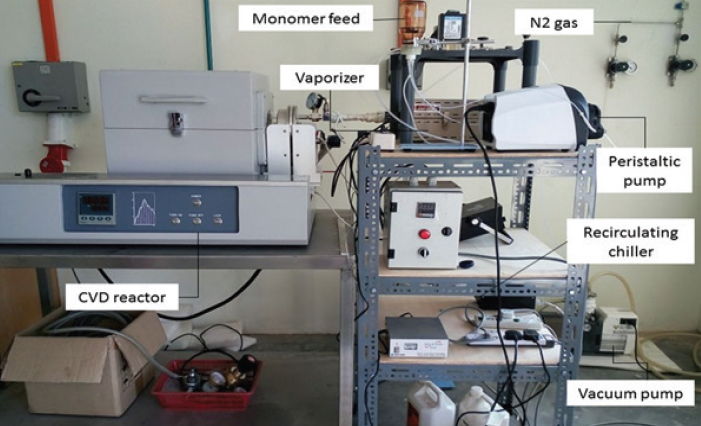
Chemical Vapour Deposition (CVD) System
The Constant Potential Philips Industrial X-Ray Model MG165 system is an X-ray system with a tube potential in the range of 7.5 – 160 kV and current between 0.5 – 45 mA (Fig. 1). The system is used as an X-ray source for calibration of diagnostic dosemeter in accordance with international standard protocols IEC 61267:2005 Medical diagnostic X-ray equipment - Radiation conditions for use in the determination of characteristics and Technical Reports SeriesNo. 457: 2007 Dosimetry in Diagnostic Radiology: An International Code of Practice.Three standard radiation qualities namely RQR, RQA and RQT have been established in compliance with these standard protocols (Table 1).
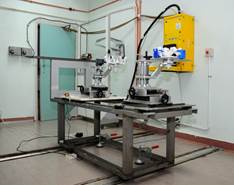
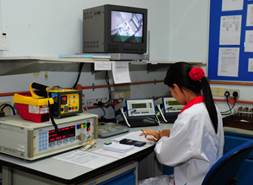
Fig. 1: Constant Potential Philips Industrial X-Ray Model MG165 system.
Table 1: Standard radiation qualities and their applications.
|
Radiation Quality
|
Application
|
|---|---|
|
RQR |
To measure beam incident on patient in general radiography, fluoroscopy and dental applications. |
|
RQA |
To measure exit beam emanating from patient in fluoroscopy application. |
|
RQT |
To measure unattenuated beam in computed tomography application. |
This PET/CT system, the first of its kind in Malaysia, provides non-invasive in vivo imaging of small animals. The combination of PET to visualize biological processes and the anatomical capabilities of CT improves the overall sensitivity and specificity of information obtained from a single scan. The primary use for the PET-CT system is in the development and validation of novel radiolabeled positron-emitting ligands, which can be used for tumor detection, diagnosis of cardiovascular and autoimmune disease or for establishing metabolic pathways.
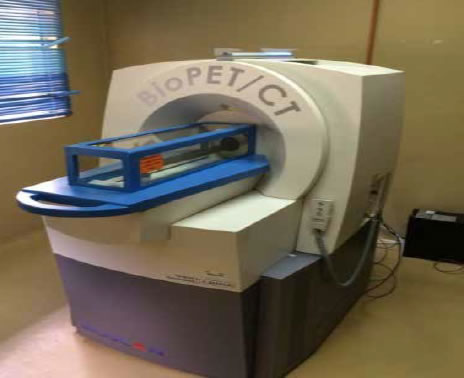
Small animal PET/CT for anatomical and functional in vivo imaging of small animals
Zebrafish has developed into a powerful system to model vertebrate disease and development using various molecular and genetic tools.Given its much closer genetic, morphological, and physiological relationship to humans, it is becoming the model of choice to discover and assess new potential drug leads.
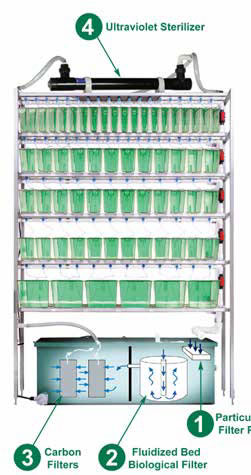
Zebrafish system to model human diseases for identification of potential new therapeutics
Solvent Extractor involves extraction, separation, isolation, purification and characterization processes of bioactive components on herbal plant extracts with therapeutic effect on cancer cells. The equipment function allows automated rinsing of the system, and post-extraction treatment, i.e. allow in-line sample clean-up to remove interferences using sorbent. It is suitable for pharmaceuticals, nutraceuticals, natural products etc.
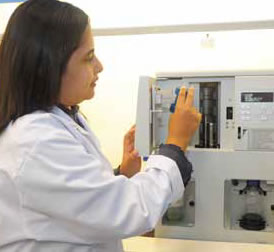
Operator is placing plant herbs for bioactive compound extraction
Glow heat fluorescence dosimeter system known as thermoluminescent dosimeter (TLD) is a tool used to measure environmental radiation levels. It is also used for measuring the dose of workers, working with various ionising radiation sources such as X-rays and radioactive materials. Measuring and monitoring environmental radiation levels are in accordance with the requirements of the Atomic Energy Licensing Regulations (Radiation Protection Basic Safety) 2010 issued by the Atomic Energy Licensing Board (AELB). This equipment is also used for continuous monitoring of Nuclear Malaysia’s surrounding areas and for providing services to private companies.
The lead equivalent thickness gauge was awarded the Gold Medal Award in Nuclear Malaysia’s Innovation Day 2010. The gauge was designed to measure lead equivalent thickness of personnel protective clothing used in Diagnostic Radiology such as lead apron, thyroid shield, gonad shield and ovary shield.
The gauge consists of four main components:
(i) Ludlum scintillation detector Model 44-71 for radiation detection in dose or dose rate units;
(ii) Lead sheets with thicknesses between 0.1 – 0.2 mmPb for establishing standard calibration curve;
(iii) Americium-241 radioactive source with gamma energy of 59 keV; and
(iv) Laptop with software for data acquisition (Fig. 1).
The gauge has been upgraded enabling wider applications in measuring various types of shielding material in different forms and sizes for use in nuclear medicine and industries. Many samples to be used as an alternative radiation shielding materials in nuclear medicine, industrial and military applications have been verified using this gauge by PhD students from local universities.
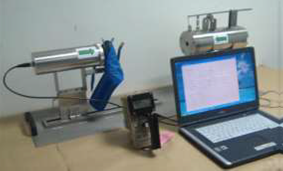
The Zetasizer (Photo 1 and 2) nano range instrument provides the ability to measure two characteristic of particles/molecules in a liquid medium; particle/molecule size and zeta potential. For particle size analysis, it uses the Non-Invasive Backscattered Scattering (NIBS) built-in technology which enables measurements of particles from 0.6nm to 6 µm. Meanwhile, for zeta potential analysis this equipment offers high sensitivity, accuracy and resolution, which is achieved using Malvern’s patented technique through a combination of Laser Doppler Velocimetry (LDV) and Phase Analysis Light Scattering (PALS).
Using this technique, even samples of very low mobility can be analyzed. This equipment brings the practicality of a maintenance-free system with the versatility of applications such as; particle size analysis including the polydispersity of colloids in the field of nano-particles, optoelectronics, proteins, polymers, and pharmaceuticals; optimizing production process using zeta potential analysis via measurement of emulsion stability, formulation stability, water treatment, pigment performance and impurity determination. The Zetasizer system is also equipped with an Autotitrator which can be used to perform fully autotitration and trend measurements.
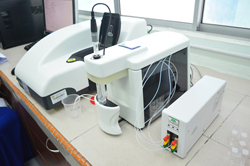
Photo 1: Malvern Zetasizer ZEN 3600
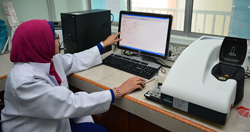
Photo 2: Sample analyzing processing using Zetasizer
The Sky Shine Radiation Detector is used to measure sky shine radiation level from irradiation facilities using gamma sources. The radiation detector is attached to a drone as Photo 8.6 and Photo 8.7, and is flown over the irradiation facility zone. Signal from detector is recorded in the form of radiation dose distribution over the irradiation facility.
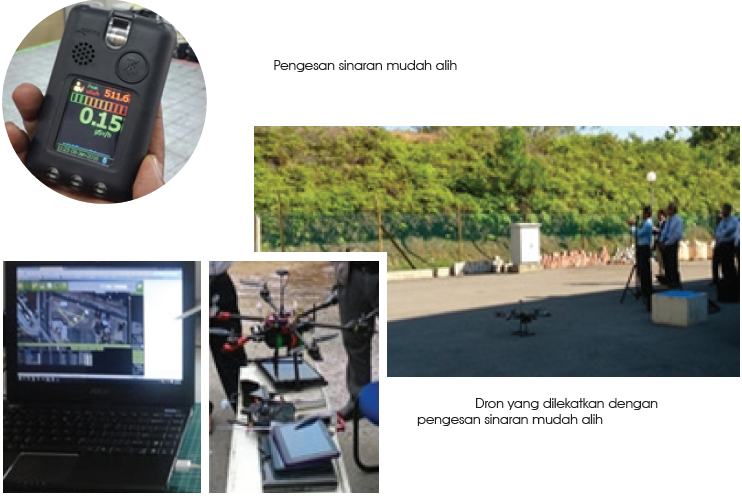
For further inquiries, please contact SISPA.
